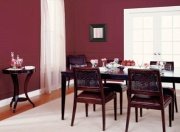Light and Dark
Home Paint Colors
Light and dark home paint colors can help you achieve different effects when painting your home. Let's see how to use them properly...
Before we talk about using light and dark home paint colors, let's tackle the terminology first. That will help you understand the lingo of designers, color experts and professional painting contractors.
![]()
When speaking about home painting colors, professionals often use the term Light Reflective Value (LRV), or simply "Value". What LRV indicates is how light or dark a color is (how much light is reflected by a color), where a low value refers to a dark color, and a high value means a light paint color.
You can usually find an LRV number of any color on the back of a paint color strip. The blackest black in a paint color deck will have an LRV of 1, while the whitest white will correspond with an LRV of 99.
How do you use this information in real life? Simple! When choosing paint colors, compare their LRV to the LRV of black (1) and white (99). A tiny paint chip can be misleading, but an LRV will give you a better idea of how light or dark the color you selected will actually "read" on the walls.
TIP: home paint colors with an LRV of 50 are considered the most optimal choice for interior house painting.
Light/Dark Home Painting Colors
and Their Effects
All things being equal...

dark paint colors can help hide/camouflage surface flaws and imperfections, while light colors will emphasize all the dents and nicks.
dark/low value paint colors visually advance, making a room seem smaller. Light/high value paint colors visually recede, creating an illusion of a bigger room.
the darker the color, the warmer it seems, and vice versa.
a glossy paint finish will make all colors seem lighter. Flat/matte paint finishes make all colors look deeper.
Using Light and Dark Home Paint Colors

one of the best ways to add drama and interest to a room, is to use variety in color values. But here's a caveat: too much value variation can look jumpy and uneven.
to create a calming and soothing atmosphere, keep most of the colors at a similar value. Just remember there is a fine line between a calm paint color scheme and a bland/boring one.
if you want to make a small room seem bigger, keep contrast between walls, ceiling and trim colors to a minimum.
contrasts in color value attract attention - keep this in mind when painting vents, electrical plates, radiators and other potential eyesores.
remember that while a dark home paint color will make a room look darker, a light paint color will never add light to a room by itself. See "Best Room Paint Colors for Dark Rooms" for ideas and suggestions.









Leave a Comment: